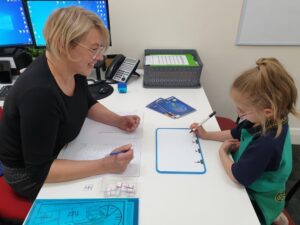How to create inclusive classrooms
“It is a heart and a head attitude. Inclusive classrooms recognise and nurture the abilities and the possibilities of all students,” says Ruth Croser, Inclusive Education Consultant with Independent Schools Tasmania.

“Inclusion begins as a core value on which physical structures, policies, processes and school communities are intentionally built by committed school leadership, each classroom teacher and teaching assistant and in fact all school staff.”
Schools should make or provide ‘reasonable adjustments’ for students to enable their access and participation within the classroom.
As the Australian Curriculum, Assessment and Reporting Authority states: “Students with disability are entitled to rigorous, relevant and engaging learning opportunities drawn from age equivalent Australian Curriculum content on the same basis as students without disability.”
According to the Nationally Consistent Collection of Data on School Students with Disability (NCCD) nearly one-in-five school students received an adjustment due to disability in 2019, making it clear that providing an inclusive classroom should be a priority for schools across the country.
A truly inclusive classroom takes into account the needs of all individual students, adopting a partnership approach between the school, teachers, students, and families to determine the best ways to support learning.
As such, School News sought to share some of the assistive devices, sensory tools, programmes and learning aids currently on the market for schools to better support their students with ASD, ADHD, dyslexia, dyscalculia, as well as physical, hearing, and vision impairments.

Physical adjustments
For students with physical limitations, mobility issues, or vision difficulties, providing safe access into and within the classroom becomes a priority. Specialised furniture to accommodate wheelchairs and other mobility aids is important, as is flexibility within the space so clear paths can be maintained for movement around the classroom.
It is vital that students with physical disabilities are not segregated away from other students. When designing new buildings, entrances and access should be able to accommodate all students, and not require separate entrances and paths for wheelchair-bound students.
An inclusive classroom also ensures that essential classroom items are placed within reach for all students, including desks, bookshelves, boards, and workstations. This can be achieved with adjustable desks and workstations or by providing a range of desks at different heights, which can then accommodate a variety of seating options to suit students who might prefer wobble stools or yoga balls to traditional chairs.
Learning differences
Proximity to the teacher and the board are two considerations when designing a classroom for students with learning difficulties, as is providing a quiet space within the room where students can work one-on-one with teachers or retreat to as a safe space when feeling overwhelmed. For dyslexic students who use text-to-voice or voice-to-text equipment, having a space within the classroom where they can work without disturbing other students but without being physically segregated is also important.
For students requiring additional accommodations, such as tablets or laptops, designing an inclusive classroom might include access to charging stations or power points.
Methodist Ladies College in Victoria, for example, established a uniquely inclusive approach to core units by pairing classroom teachers with a specialised Learning Diversity teacher in the hopes of better supporting students with additional needs within the classroom and reducing rates of student withdrawal.
As Ruth Croser remarked: “Inclusion involves considering what the possible barriers might be in terms of these physical structures, policies, processes, and community and either removing these or making adjustments so students can participate as much as possible just like their peers in school life.
“Inclusive classrooms consider and adjust for the individual, personalised learning needs of students to enable them to reach their potential.”

Industry Insights: Inclusive classroom tools and program design
Director of Education and Professional Learning at Speld SA, Kerry Williams, is also an accredited Sounds-Write trainer, and told us:
“When choosing a quality classroom program, it is important to look for the evidence of its efficacy; teachers often require additional training in evidence-based practice too.
“Reading and spelling programs should be explicit, systematic, and cumulative, gradually building on skills and conceptual knowledge with multisensory engagement. This means abandoning some practices such as predictable readers and sight words.
“Learning abstract literacy and maths concepts can be supported with concrete materials that provide visual support, for example the use of MAB blocks in maths and sound/spelling tiles when teaching literacy. Ensure tasks are broken down into smaller steps and carefully scaffolded so that the task is clear and not overwhelming.
Centrally, Kerry advised schools to “seek out training in supporting students with learning difficulties and disabilities”.
“There are many free or low-cost webinars available online, but also collaborate with others who work with your students, including inclusive education teachers, speech pathologists, occupational therapists, and support staff. Parents can also be a wealth of knowledge when it comes to working with their child.
“High school can be particularly challenging for students with additional learning needs, as they move between teachers with different expectations throughout the school day. Draw on the strengths of your students and adjust tasks accordingly to allow them to demonstrate their skills and knowledge, and to experience success – it’s a great motivator!”
For Julia Clouter, Global Head of Education at Scanning Pens: “An assistive technology toolbox to support literacy is a quick win but nearly as rare as hens’ teeth in the primary classroom.
“They don’t have to be high tech—think colour overlays, pencil grips, tangle toys, a magnifying lens, rulers with colour slots to help read single lines of text, highlighters, post-it notes, ReaderPens, audio books, and motivational bookmarks.”
Sharing her top five inclusive practices for teachers, Julia advised:
- “On your seating plan, include the student’s reading age score. This is my top tool when scaffolding readability for all of my students.”
- “Support the need for sensory feedback by sticking a bit of velcro under the student’s desk and explain there’s gritty material on one side and smooth on the other. This can be a discreet but helpful soother for sensory-seeking students.”
- “Take a photograph of your students’ workstation with all the tools that help them laid out and their name in the middle. This creates a record of supports you can share with a supply teacher, or pass to the student’s next teacher.”
- “Help dyslexic students to help themselves by providing a ReaderPen that will do the reading and de-coding for them so your TA will have more time to support learning rather than reading.”
- “Students with ADHD find time turners helpful so build transition time into your instructions. For example, announce that everybody is going to work for 10 minutes and then have two minutes of tidy up time.”

“Quite often a school will purchase a single-user software application for a particular student, then realise it can benefit all students so purchase a multi-user licence,” revealed Michael O’Leary, Managing Director at Spectronics, as he shared some examples of classroom tools and software with School News:
“Software applications such as Boardmaker and Clicker for primary school students, and Docs Plus for high school students, have ready-made and shared activities and classroom resources available for download that can help teachers with preparation time and are packed with multi-media features like videos, graphics, talking books, picture communication symbols, as well as accommodations such as mind mapping programs and tools like word prediction, text-to-speech, and even symbol software.
Moreover, he said: “The same software applications have analytics tools that can give unique insights into each learner’s writing process, helping teachers to make informed decisions about their current support levels and the most effective next steps.”
He added that “many States and Territories have approved the use of Reader Pens for students in their exams, so that students who have reading difficulties such as dyslexia can independently take exams—no special access arrangements are required.
“For people with hearing impairments, the BrightSign Glove, is the only smart glove in the world that can translate any sign into any spoken language, and for people with mild-low vision impairment, reading fatigue, or reading challenges, the OrCam Read is a handheld device with a smart camera that reads text from any print or digital surface.”




